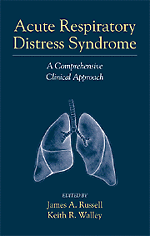Book contents
- Frontmatter
- Contributors
- Contents
- Preface
- Introduction
- 1 Overview, Clinical Evaluation, and Chest Radiology of ARDS
- 2 The Epidemiology of ARDS
- 3 The Pathology of ARDS
- 4 Cytokine -Induced Mechanisms of Acute Lung Injury Leading to ARDS
- 5 Pulmonary Pathophysiohgy in ARDS
- 6 Cardiovascular Management of ARDS
- 7 Mechanical Ventilation
- 8 Respiratory Muscles and Liberation from Mechanical Ventilation
- 9 Clinical Assessment and Total Patient Care
- 10 ARDS: Innovative Therapy
- 11 Nosocomial Pneumonia in ARDS
- 12 Resolution and Repair of Acute Lung Injury
- 13 Multiple System Organ Failure
- 14 Outcome and Long-Term Care of ARDS
- Index
13 - Multiple System Organ Failure
Published online by Cambridge University Press: 05 October 2010
- Frontmatter
- Contributors
- Contents
- Preface
- Introduction
- 1 Overview, Clinical Evaluation, and Chest Radiology of ARDS
- 2 The Epidemiology of ARDS
- 3 The Pathology of ARDS
- 4 Cytokine -Induced Mechanisms of Acute Lung Injury Leading to ARDS
- 5 Pulmonary Pathophysiohgy in ARDS
- 6 Cardiovascular Management of ARDS
- 7 Mechanical Ventilation
- 8 Respiratory Muscles and Liberation from Mechanical Ventilation
- 9 Clinical Assessment and Total Patient Care
- 10 ARDS: Innovative Therapy
- 11 Nosocomial Pneumonia in ARDS
- 12 Resolution and Repair of Acute Lung Injury
- 13 Multiple System Organ Failure
- 14 Outcome and Long-Term Care of ARDS
- Index
Summary
Introduction
Multiple system organ failure (MSOF) is important in management of patients who have ARDS for several reasons. First, MSOF is the most common cause of death of patients who have ARDS. Furthermore, development of multiple system organ dysfunction is a predictor of death of patients who have ARDS. Second, ARDS is basically the expression of lung failure in critically ill patients who have multiple system organ failure. That is, ARDS and MSOF are inextricably linked and are not really separate issues. Third, MSOF is extremely costly. Indeed, a significant portion of any ICU budget is spent on patients who have MSOF because of the intensity and duration of support.
This chapter reviews what MSOF is, why it is important, how it occurs, and how it can be predicted. The clinical management of organ failure is presented in Chapter 9 on total patient care. Here we first review several definitions of MSOF. We then describe the epidemiology of MSOF in ARDS. Then, the pathophysiology of MSOF is presented, especially the role(s) of tissue hypoxia as a cause of MSOF. Finally, we evaluate several methods to predict MSOF.
Definitions of Multiple System Organ Failure
The definitions of organ failure versus organ dysfunction require clarification. Organ failure is organ dysfunction of such severity that life support is required. Organ failure is associated with significant morbidity and mortality. Organ dysfunction defines the dynamic process of organ dysfunction, which ranges from mild to extreme.
- Type
- Chapter
- Information
- Acute Respiratory Distress SyndromeA Comprehensive Clinical Approach, pp. 304 - 333Publisher: Cambridge University PressPrint publication year: 1999



